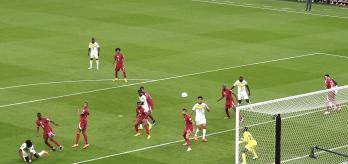Fully 19% of all goals at the tournament (excluding own-goals and penalty kicks) came from a set piece, with 1 in 35 corners and 1 in 27 free kicks resulting in goals. In light of these statistics, it is no surprise that coaches are placing more and more emphasis on defending set pieces.
This article draws on examples from FIFA World Cup Qatar 2022™ to explore some of the defensive tactics and strategies teams used when defending corners at the tournament. It is notable that teams were generally very consistent in their defensive setups and tended not to alter their approaches from game to game, although they did sometimes make one positional change in order to deal with a specific nuance of an opposition corner routine.
Interestingly, of the 32 teams that competed at the tournament, only five defended with a player positioned on at least one post, and only six teams left a player higher up the pitch when defending a corner. This means that 26 teams brought all ten outfield players back to defend corners, demonstrating their strong determination not to concede from set pieces.
In addition, the most popular defensive setup in this competition was a hybrid approach in which teams used a combination of zonal marking, player-to-player markers and “edge” players (players stationed at the edge of the penalty area). The precise configuration of this hybrid varied from team to team, with some favouring more zonal defenders and others preferring more player-to-player markers and blockers.
For the purposes of this article, our Football Performance Insights team have categorised setups for defending corners as follows:
-
ZONAL SETUP: A defensive setup is defined as zonal when a team assigns zonal (rather than player-to-player) defensive responsibilities to four or more players.
-
PLAYER-TO-PLAYER SETUP: This is a defensive set-up in which a maximum of three players are assigned zonal defensive responsibilities, with the majority of the defending side designated as player-to-player markers.
The zonal setup
In the zonal system, teams position four or more of their players in specific locations in the penalty area. These players are allocated the responsibility of defending their assigned zones (as opposed to taking responsibility for any individual opposition player) and they tend to focus on the trajectory of the ball rather than looking to see where opposition players are moving. The thinking behind this approach is that if the defender wins the ball when it comes into their zone, it doesn’t matter which opposition players try to enter that zone; after all, they cannot score unless they can win the ball.
In this system, the starting positions of the players and the spaces between them are very important. This is because the defending players are almost always competing for the ball from a static position, which can reduce leverage and reduce the maximum height of their jumps when battling for the ball in the air. In addition, an accurate delivery to an area between two zonal markers can result in a great chance for an attacker, especially if they time their attacking run correctly and the defenders fail to track it.
It was striking that, of the 13 teams at this competition from UEFA, eight of them (62%) favoured a more zonal setup, (defined as a setup featuring four or more zonal defenders). This percentage was significantly higher than for any other Confederation: 50% of teams from Concacaf, 40% from CAF, 25% from CONMEBOL, and just 17% of teams from the AFC opted for a zonal-based approach to defending corners.
Croatia
The graphic below shows Croatia’s preferred starting position for defending corners, with four zonal markers in the goal area (i.e. in the six-yard box) and an additional player stationed on the front post. They also have three player-to-player markers and two more players assigned to deal with any balls to the edge of penalty area. In this instance, the four zonal defenders do not leave their zones, while the player on the front post and the “edge” player nearest the ball are primed to deal with a potential short corner by moving out to press the attacking player who receives the short pass
Korea Republic
Some teams relied much more heavily on a zonal setup. The example below reveals how Korea Republic assigned a total of eight outfield players to zonal marking responsibilities. Seven of those players framed the goal area (the six-yard box) while the other was positioned just outside the penalty area to guard against a short corner. Their remaining two available players were designated player-to-player markers, meaning they opted not to cover the edge of the penalty area.
This proved to be an effective strategy for the Koreans, as they did not concede a single opportunity from a corner during the tournament. This performance put them in the top three teams at the tournament for fewest chances conceded from corners.
First contact with zonal defending
An examination of data on the number of first contacts won by defending teams (i.e. the number of times the defending side won the first ball from a corner) shows that two of the top three teams by this measure used a heavily zone-based system: USA (5 zonal markers) had an 84% first contact rate, while Germany (6 zonal markers) won 75% of first balls from corners.
The graphics below illustrate exactly how both of these teams strategically allocated their players to zones covering the frame of the goal from the front post to the back post. These defenders were tasked with dealing with any ball that came into their zone and ensuring they won the first contact in their zone. They were not responsible for marking any individual opposition players; the designated player-to-player markers were expected to fulfil that role.
The player-to-player setup
In contrast to the zonal approach, some head coaches prefer their players to focus their attention on individual opposition players with a view to marking them out of the game, rather than defending zones of the penalty area. In this scenario, the defending players (markers) are each allocated an opposition player for whom they must take complete responsibility. The defender’s job is to stop their assigned player from playing a significant role in the opposition’s attacks. In order to do that, they are expected to track or prevent attacking runs, make sure they get to the ball ahead of their opponent, or position themselves in a way that prevents their opponent from getting a shot on target.
Data for the 2022 World Cup shows that three of six teams that conceded the fewest attempts at goal from corners used player-for-player-based set-ups (Uruguay, Spain and England). It was also notable that 83% of teams from the AFC and the OFC tended to favour a man-to-man setup, with five of their six teams deploying three zonal defenders or fewer in this tournament.
Spain
In this case study, nine of the 32 teams (28%) used just two zonal defenders at corners, with the rest of their outfield players assigned as player-to-player markers and/or edge players.
Spain were one of the minority of UEFA teams that preferred a player-to-player approach to defending corners during the tournament. The illustrations below also emphasise the fact that Spain brought all ten outfield players back to defend corners against Germany, and assigned six of those players to player-to-player marking duties. They operated with two zonal defenders charged with covering the six-yard box, and had another two players allocated to dealing with balls played to opposition players around the edges of the penalty area.
Ghana
In this case study, 15 of the 32 teams competing deployed two or three zonal defenders, with the remaining players marking player-to-player, guarding the posts, patrolling a line at the edge of the penalty area or remaining higher up the pitch. The diagram below shows how Ghana used two zonal markers directly in front of the middle of the goal and another zonal defender at the front post. The three zonal defenders were supported by five player-to-player markers and two “edge” players. Again, they opted to bring all ten outfield players back to defend corners.
In this illustration, Korea Republic create a numerical advantage outside the penalty area and play a short corner. The Ghana defender on the front post and the “edge” player closest to the ball immediately leave their starting positions in attempt to put pressure on the ball, while the two zonal defenders and five player-to-player markers stick to their roles.
Uruguay
Uruguay were another team that proved extremely effective when using a player-to-player-based defensive setup. They did not concede a single attempt on goal when defending a corner, which was testament to the prowess of a defensive shape that featured two zonal defenders and six markers. In the second example shown here, they have a spare player (a player-marker) because Portugal choose to keep four players outside the penalty area. This leaves Uruguay with nine players defending the penalty area against Portugal’s five attackers.
Conclusion
Of the two systems discussed here, there is no statistical evidence suggest that one system is intrinsically better than the other; the teams at this tournament showed that zonal and player-to-player marking can be equally effective. However, the numbers do indicate that that more teams are defending corners with all ten outfielders back in their defensive third, foregoing the option of leaving one player higher up the pitch. One reason for this development could be the need to avoid playing the opposition onside from flick-ons into the goal area. In addition, fewer defending teams were found to be stationing players on the posts. Whichever system they employ, it seems that teams do not generally deviate from their preferred setup, although they sometimes change the role of a single player to deal with a nuance in an opponent’s attacking routine.
This all suggests that there is no absolute ‘best’ setup when it comes to defending corners. Often, the defensive structure employed by teams in these scenarios is chosen at the discretion of the head coach, and is based on their preferred method of dealing with set pieces. That decision will also be influenced by the players at their disposal, since it is the coach’s responsibility to get the best out of their squad. As coaches are only too well aware, while individual statistics can provide useful insights into the way football is developing, their jobs depend on the stat that matters most: the scoreline.

















